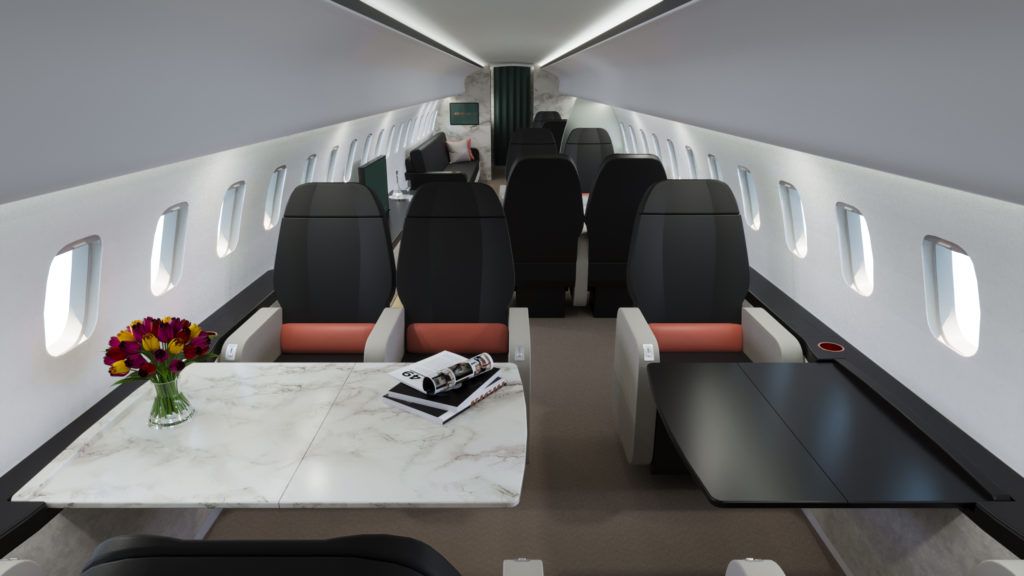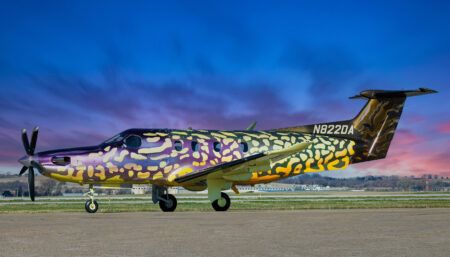Five premium cabins have been unveiled to enable business aircraft operators to benefit from the fuel efficiency of turboprops over short distances, without skimping on cabin size
Regional aircraft manufacturer ATR has taken aim at business aircraft operators, heads of state and semi-private airlines with a new collection of five premium cabins for its ATR 72-600, ATR 42-600 and ATR 42-600S turboprop aircraft. The company unveiled the ATR HighLine collection at Aircraft Interiors Expo (AIX) in June 2023.
The three turboprop models share the same cross-section, yielding a cabin volume that Louis Barral, business development manager at ATR, says is much bigger than other business turboprops, and actually equivalent to the largest business jet. “The idea is not to compete with large business jets that address different markets like transatlantic flights,” he explains. “But large business jets often fly on short routes of one hour, and we think that doesn’t make sense. This is the market we want to address.”
Short hops
Although ATR aircraft can fly much further, Barral says they are best suited to missions of around 250 nautical miles (463km), where turboprop technology provides great fuel-efficiency benefits over jets. “Compared with a jet of the same size, our aircraft use 45% less fuel [over these missions],” says Barral.
He adds that another advantage of the ATR turboprops is that they can use short runways, especially the in-development ATR 42-600S, where ‘S’ signifies short take-off and landing.
Around 200 airlines operate ATR aircraft in 100 countries currently. “We tackle the commercial segments very well today, but we know that business aviation is facing a lot of challenges in most economies,” comments Barral. “So we decided we can bring the superiority of turboprop technology for short routes, but we need the right level of comfort on board, and our economy configuration does not work for the business aviation sector.”
Multi-Class
The first of the five ATR HighLine cabins is called Multi-Class. “It addresses commercial airlines rather than business aviation, but in a more premium way compared with a standard economy configuration,” says Barral. Focussing on the US airline market in particular, the layout features 2-1 premium seating followed by 2-2 economy seating. A triple-class, 50-seat layout on the ATR 72-600 would feature 12 seats in first, 12 in economy plus and 26 in economy. Features include dual passenger boarding doors; boarding bridge connection; a front galley; power outlets; and internet connectivity.
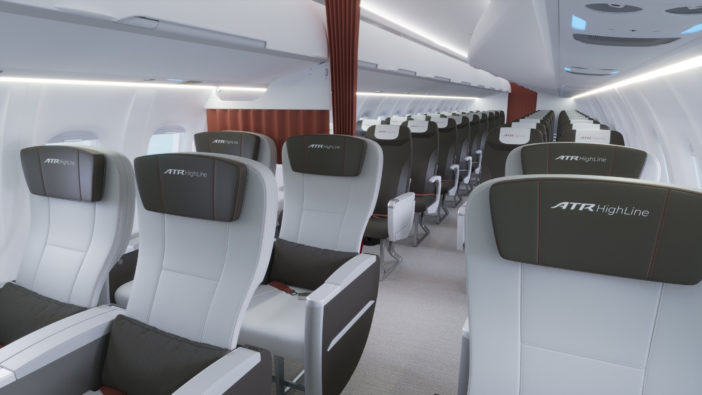
Premium-Flex
The next step up is Premium-Flex. The standard ATR economy configuration has 2-2 seats. Premium-Flex enables any double seat (which is 18in wide between armrests) to be converted into a more premium single seat that is 20in wide. This is achieved by removing one seat backrest and cushion and plugging in an X-Space Table instead, fixed on the seat structure. “When you don’t need a table, you remove it and put back a seat,” says Barral. “This is great for charter operators that want to offer a premium atmosphere, and if they need more capacity the next day, they can remove the table and fly with more seats.”
Premium-Flex can accommodate more than 60 seats, or on the other hand, cater to the market for 30 seats and under. “A 30-seat configuration addresses the Part 135 market in the USA, which is limited to 30 seats by the regulation,” says Barral. “Chinese general aviation operators are also limited to 30 seats, so this addresses those markets.”
The cabin still features overhead baggage compartments, and also has ambient LED moodlighting, and USB power outlets at each seat.
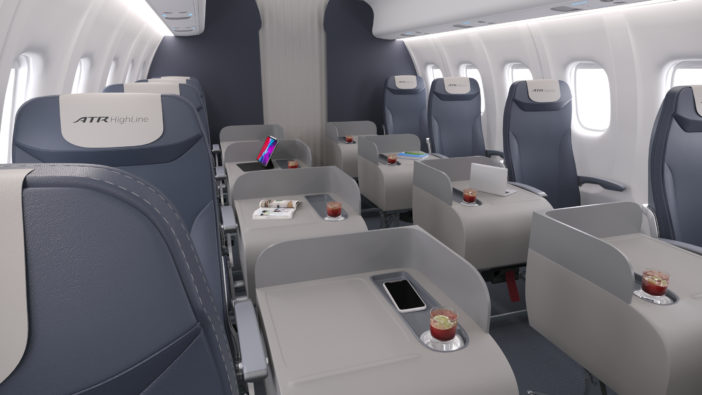
All-Business Class
The third cabin is called All-Business Class. On the ATR 72-600 this means 30 business seats in a 1-1 layout with an extra-large aisle. “The super-wide cross-section means we can even have a side console for each passenger – which you can’t have on regional jets,” says Barral. “We can remove the overhead bins to create an atmosphere like a private aircraft.”
The 30-seat layout again makes this a proposition for the Part 135 segment – with potential applications including touring sports teams, corporate shuttle transport and resort use.
“There are some hotels and resorts in Malaysia, the Philippines and the Maldives that have created their own airlines based on the ATR, but today they fly with economy configurations,” explains Barral. “They are asking us to go more into this direction.”
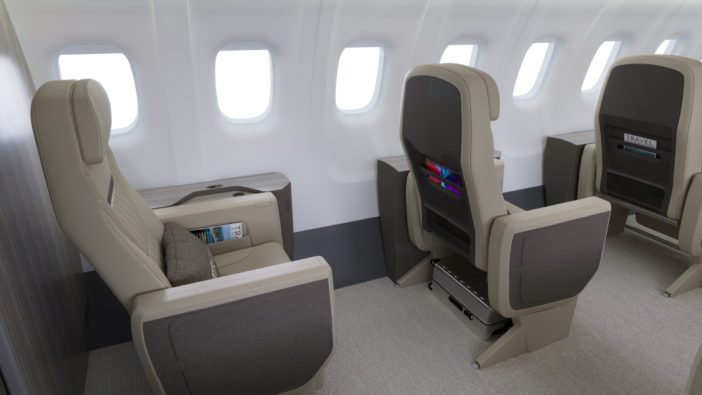
Multi-Section
The fourth configuration, the Multi-Section interior, enables sections of the cabin to be split off with a sliding door. This enables a VIP private area at the front, for a head of state for example, and economy seating at the back that could be used to transport staff or troops, or for other purposes like medical evacuation. For the ATR 72-600, the company envisages a 56-seat layout with seating for two bodyguards, two VIPs and 52 in the economy section.
The dual cabin is supported by separate boarding doors, galleys and lavatories. Meanwhile, the four-window VIP area features seating with electric controls; sideledges with folding tables; and a wardrobe.
The intention is for the officials to fly in style and comfort, but also efficiently. “They have to lead by example in some way, so we think this is a nice product for them,” says Barral.
He shares that this interior is already in service, and there is a customer for the All-Business Class option too.
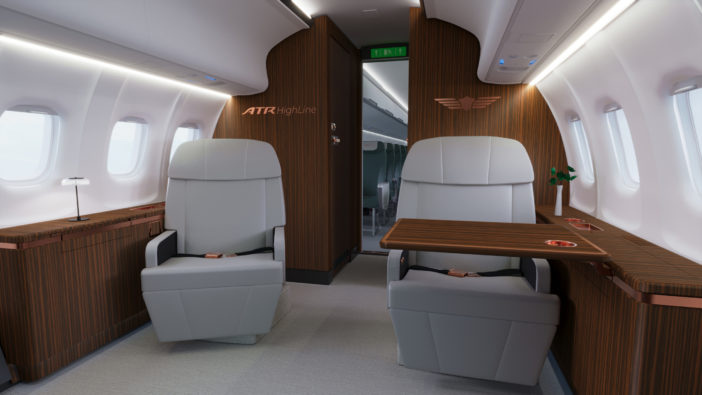
Bespoke VIP
The final cabin is the Bespoke VIP interior. Here ATR will partner with some (currently undisclosed) DOA MRO completion centres to provide customised interiors. “If customers need a different cabin from those we introduced before, we can do it,” says Barral.
The approach would resemble that taken by Airbus and Boeing with ACJs and BBJs. ATR would deliver a green aircraft to the MRO to fit the interior, with each case certified by STC. ATR is a joint venture between Airbus and Leonardo, and Barral notes that like Airbus, ATR is offering commercial aircraft with high-end cabins. “We work well with ACJ, we are part of the same group, so they support us a lot on this initiative as well,” he adds.
On the ATR 72-600, a 16-seat layout might include a six-person club arrangement; a conference section with four seats around a table, with a large screen installed with a credenza; a third seating area for six with a divan, four seats and a table; then a full galley. Seats would be fully berthing, with swivel. However, Barral emphasises full customisation is possible. “The STC providers can work directly with a customer to customise it,” he explains. “They can draw renderings, show different materials; they can answer any demand, even source new products, new materials, if the end customer wants it.”
Barral says the ATR HighLine collection garnered great interest at AIX, and he characterises it as a “disruptive proposition” – a large turboprop with a high-end cabin. “We don’t describe our offer as a business aircraft,” he says. “We offer a commercial aircraft with a high-end VIP cabin. Business aircraft are limited to 19 seats, because of regulations. We can go up to 50 passengers, because we follow commercial aircraft regulations. It gives us a lot of flexibility.”
This feature, written by Izzy Kington, was first published in the September/October 2023 edition of Business Jet Interiors International.


